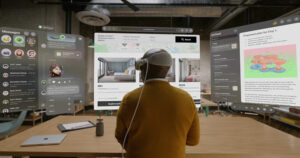
Microsoft kicked off its Build 2013 developers conference on Wednesday with the announcement that its highly anticipated Windows 8.1, aka “Windows Blue,” has arrived.
CEO Steve Ballmer also said that rapid release will be the new norm in the Microsoft ecosystem, and that Redmond will transform Windows devices.
“Rapid release’s cadence is fundamental to everything we’re doing and to the way we’re going to mobilize our ecosystem of hardware and software partners,” Ballmer said.
Microsoft’s move to mobile “is not just about phones,” he continued, “it’s about transformation and innovation in the fundamental hardware we think of as a Windows device.”
That transformation will lead to small tablets, Ballmer noted as he showed off an 8.1-inch Acer Iconia tablet running Windows 8, declaring it “perfect for students.” It comes with Microsoft Office preloaded.
Ballmer also talked about Microsoft’s move to make existing traditional Microsoft applications run well on Windows 8.1 without any revamping.
“We got a lot of feedback from those users of those millions of [traditional] desktop applications that said, in coffee terms, ‘Why don’t you go out and refine the blend?'” Ballmer said, “so what we will show you today is a refined blend of our desktop experience and our modern user interface and applications experience.”
Microsoft is bringing back the Start button to the desktop, Ballmer announced, to loud applause from the audience.

Finally, the Windows 8.1 shell experience is powered by Bing, and Microsoft is opening up Bing as an application development platform “so you can use all the investment we have put into crawling the Web and build that richness into core applications running on Windows,” Ballmer said.
What Microsoft’s Changes Might Mean
Windows 8.1’s “long list of features,” the app store redesign, its enablement of enterprise integration, Microsoft’s retail work with Best Buy, the new device sizes, and the fact that Windows Blue is free “could amount to a game changer for this platform,” Al Hilwa, a program director at IDC, told TechNewsWorld. Windows 8.1 “could see a significant increase in adoption.”
Microsoft “has missed the market in Windows 8, missed expectations in RT, and just plain missed the entire opportunity in mobile devices,” Jim McGregor, principal analyst at Tirias Research, told TechNewsWorld, “but they are pretty good about getting it right in PCs the second, third or fourth time around.”
The shift to rapid release indicates Microsoft “is investing in order to ensure that the engineering process stays on the rails and releases like Windows Vista don’t occur again,” remarked Wes Miller, an analyst at Directions on Microsoft.
Baby Tablets
The small form factor is “very important,” Ballmer said. “This is innovation that has to be unlocked.” Microsoft will work with partners in semiconductors and system design to bring the small form factor to light.
“I believe Microsoft is following their partners, who are following the market,” Directions on Microsoft’s Miller suggested. “OEMs were surely pulling Microsoft to support smaller form-factor tablets,” which are less expensive to make. The not-Apple market generally seems to be trending to fighting on price.”
Microsoft “is opening up its capabilities and starting to show what a Windows-based solution could entail, and it’s going to start with smaller tablets,” Jeff Orr, a senior practice director at ABI Research, told TechNewsWorld. “You don’t want to see Microsoft necessarily competing with Android or iOS head-on — they want to carve out their own space.”
The Blending of the Apps
There are now more than 100,000 apps in the Windows app store, and these join a list of “literally millions of applications that people use in Windows today,” Ballmer said. There are about 3 million such apps, which “are essential to the stuff we get done every day.” Microsoft wants to make sure it offers a path forward for users of these apps.
“I think Microsoft stands a better chance of success with the [Windows 8.1] platform by not shunning their desktop legacy,” Miller told TechNewsWorld, “but by trying to get potential buyers to understand where the legacy apps and WinRT apps do make sense together.”





















































